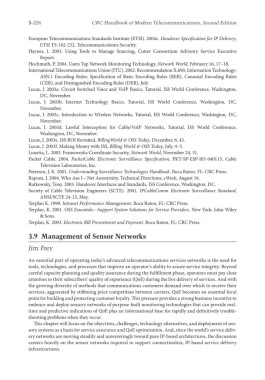Page 435 - Handbook of Modern Telecommunications
P. 435
3-226 CRC Handbook of Modern Telecommunications, Second Edition
European Telecommunications Standards Institute (ETSI). 2004c. Handover Specification for IP Delivery,
ETSI TS-102-232, Telecommunications Security.
Haynes, I. 2003. Using Tools to Manage Sourcing, Cutter Consortium Advisory Service Executive
Report.
Hochmuth, P. 2004. Users Tap Network Monitoring Technology, Network World, February 16, 17–18.
International Telecommunications Union (ITU). 2002. Recommendation X.690, Information Technology:
ASN.1 Encoding Rules: Specification of Basic Encoding Rules (BER), Canonial Encoding Rules
(CER), and Distinguished Encoding Rules (DER), July.
Lucas, J. 2003a. Circuit Switched Voice and VoIP Basics, Tutorial, ISS World Conference, Washington,
DC, November.
Lucas, J. 2003b. Internet Technology Basics, Tutorial, ISS World Conference, Washington, DC,
November.
Lucas, J. 2003c. Introduction to Wireless Networks, Tutorial, ISS World Conference, Washington, DC,
November.
Lucas, J. 2003d. Lawful Interception for Cable/VoIP Networks, Tutorial, ISS World Conference,
Washington, DC, November.
Lucas, J. 2003e. ISS ROI Revisited, BillingWorld & OSS Today, December, 6, 43.
Lucas, J. 2003f. Making Money with ISS, Billing World & OSS Today, July, 4–5.
Lunetta, L. 2003. Frameworks Coordinate Security, Network World, November 24, 31.
Packet Cable. 2004. PacketCable Electronic Surveillance Specification, PKT-SP-ESP-I03-040113, Cable
Television Laboratories, Inc.
Petersen, J. K. 2001. Understanding Surveillance Technologies Handbook. Boca Raton, FL: CRC Press.
Rapoza, J. 2004. Who Am I—Net Anonymity, Technical Directions, eWeek, August 16.
Rutkowsky, Tony. 2003. Handover Interfaces and Standards, ISS Conference, Washington, DC.
Society of Cable Television Engineers (SCTE). 2001. IPCableComm Electronic Surveillance Standard,
ANSI/SCTE 24-13, May.
Terplan K. 1999. Intranet Performance Management. Boca Raton, FL: CRC Press.
Terplan, K. 2001. OSS Essentials—Support System Solutions for Service Providers. New York: John Wiley
& Sons.
Terplan, K. 2003. Electronic Bill Presentment and Payment. Boca Raton, FL: CRC Press.
3.9 Management of Sensor Networks
Jim Frey
An essential part of operating today’s advanced telecommunications services networks is the need for
tools, technologies, and processes that improve an operator’s ability to assure service integrity. Beyond
careful capacity planning and quality assurance during the fulfillment phase, operators must pay close
attention to their subscribers’ quality of experience (QoE) during the live delivery of services. And with
the growing diversity of methods that communications customers demand over which to receive their
services, aggravated by stiffening price competition between carriers, QoE becomes an essential focal
point for building and protecting customer loyalty. This pressure provides a strong business incentive to
embrace and deploy sensory networks of purpose-built monitoring technologies that can provide real-
time and predictive indications of QoE plus an informational base for rapidly and definitively trouble-
shooting problems when they occur.
This chapter will focus on the objectives, challenges, technology alternatives, and deployment of sen-
sory systems as a basis for service assurance and QoE optimization. And, since the world’s service deliv-
ery networks are moving steadily and unwaveringly toward pure IP-based architectures, the discussion
centers heavily on the sensor networks required to support connectionless, IP-based service delivery
infrastructures.

